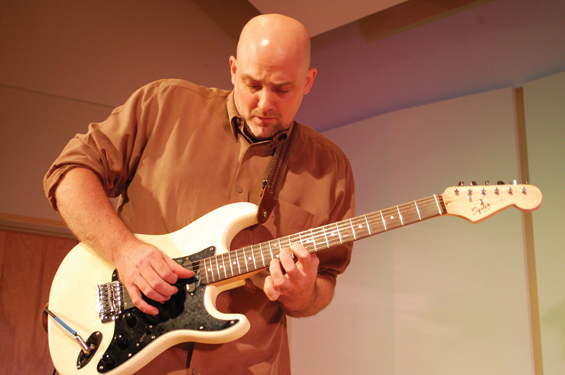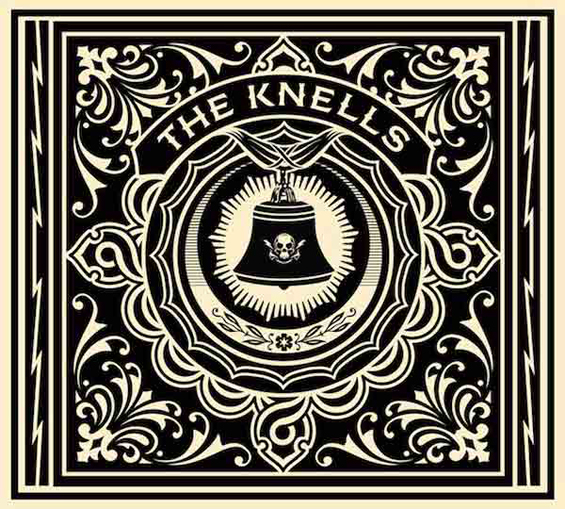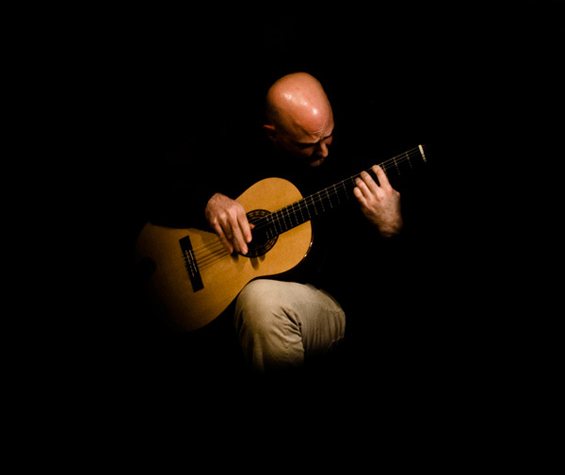

photo: Ron Silver
BACKTRACKING WITH THE KNELLS' THE KNELLS
As if releasing one of 2013's most original sounding albums wasn't enough (read the textura review here), The Knells now complement that feat with an in-depth, track-by-track breakdown of its self-titled debut album (which also, incidentally, nabbed the number nine slot in textura's 2013 top 20 albums list). Fronted by guitarist-composer-lyricist Andrew McKenna Lee, the ensemble's bold fusion of guitar-heavy prog-rock with classical singing and string quartet playing sounds unlike anything else released in 2013. It's wonderful to be granted such insight into the recording by those who created it, and we are indebted to those who contributed to this illuminating album overview: Andrew McKenna Lee, guitar and writer (AML); Nina Berman, soprano (NB); Amanda Gregory, mezzo (AG); and Mike McCurdy, drums (MM).
“AIRLIFT”
AML: The instrumental intro of this track is probably one of the highlights of the album for me. The chiming guitar texture—interwoven with Joe's tight, sinewy bass line and Mike's melodically nuanced drum part—falls through a series of unsettled, blues-influenced riffs and harmonies that conjure an image of “‘70s classic rock meets chamber music.” Not so incidentally, this is one of the ideas that underlies the whole album.
The part that makes it for me, though, is at 3:58 when the groove finally sets in. This whole section is a mishmash of parts in different meters, which lends it a revolving, kaleidoscopic kind of feel. I love the way Nina and Amanda's vocals float above it all, with Katya's lower countermelody supporting them. The strings play along while Paul drifts in and out of the texture with the vibraphone in various, slightly askew patterns of guitar harmonics.
NB: “Airlift” has a really relaxed, easy groove to it, which is interesting because the lyrics are anything but! Andrew not only wrote unusual and interesting music, but also managed to compose his texts in a way that beautifully juxtaposes spun-out, lyrical lines with the feelings of emptiness and yearning on the search for something greater than oneself.
MM: The opening of this tune reminds me of a band I loved in college (and still love!) called Polvo. That guitar lick of Andrew's inspired me to come up with something reminiscent of a drum line they might have had... melodic and heavy.
The middle of this tune is one of my favorite sections on the entire record. Around 4:30, it coalesces into an anthemic, beautiful, almost-chorus. This is one of the things I think Andrew has really excelled at in this album, and one of the things that is so new with this sound: creating pop-like structures without having hardly any pop-like structures.
“THREAD” and “FRAY”
AML: Although they're two different tracks, these two tunes definitely go together. “Thread,” with its reverbed-out wah-wah guitar and backwards loops, is supposed to sound something like a human lava lamp. In contrast, “Fray” is really like a huge anthemic ballad, propelled forward via a solid chord progression and a distinctive rhythmic pattern in the kick drum. Paul's tremolo'd-out guitar part creates a beautiful sense of depth and space amidst an ensemble texture that's quite dense and homophonic.
NB: The harmonies of “Thread” are full of unresolved dissonances, which I like to think of as Andrew's modern-day answer to the intense word painting of certain Baroque and Renaissance composers, most specifically, Monteverdi. I like his description of “Thread” as “a human lava lamp —it's very apt. He purposefully confuses the listener's sense of pulse: accents on different parts of the measure make it delightfully difficult to discern whether the meter is in two or three.
As “Thread” dissolves into “Fray,” we are suddenly thrown into the realm of more traditional harmony and are relieved by three voices singing in thirds. It feels like an intense release after the ambiguity of “Fray”; however, the two-versus-three dichotomy of the metric structure in “Fray” is expanded to the level of the bar: instead of creating ambiguity around the pulse, Andrew begins to play with measures of three versus measures of two. As in “Airlift,” this appears to be a subtle form of text painting: the lyrics describe the seemingly futile attempt to hold on to the beautiful moments in our lives even though they will inevitably slip away into nothingness—the classic existentialist's dilemma exemplified musically!
AG: We all have our own conversations about time, but Andrew's lyrics in this piece are intensely real for me. I come out of the texture and sing “As they fall through your fingers,” referring to both time and water. I think about this line as I watch the countdown on a crosswalk across the street. This piece closely represents my experience of time and its rapid loss.
MM: “Fray” was one of the most difficult drum parts to come up with on this record, but once it was laid down, it sounds so easy. Andrew and I had many a debate over the course of rehearsing this song about what the feel was going to be like. After a frustrating first few takes when recording it, I really wanted to take what Andrew had in mind (heavy tom beats to match his guitar line) but break it down to its core, so I just laid down a steady, slowly crescendoing 8th-note ostinato on the snare under accents on the kick and snare to match Andrew's guitar line. And that's what the music was calling for—it just took a long time to discover it.
“DYING IN WAVES”
AML: “Dying in Waves” is my personal response to the idea of the “guitar solo” and its place in rock music. I knew that I didn't want guitar solos (at least in the conventional sense) to feature heavily on the album. As a kid, I was always heavily drawn to Jimmy Page's acoustic musings, like “White Summer / Black Mountain Side” and “Bron-Yr-Aur,” tunes that influenced me greatly and are in many ways partly responsible for my eventually getting into classical music. “Dying in Waves” is my way of responding to those songs and is really an homage to Mr. Page.
MM: Not much to say here, other than that Andrew deserves the Pulitzer Prize for his phenomenal guitar solo.

“DISTANCE”
AML: Interestingly, “Distance” is really just “Dying in Waves” with the band. The harmonic progression and the motives are all essentially the same, the exception being the bridge in the middle, where the MIVOS Quartet completely shreds a string quartet solo. This was another manifestation of my wanting to address the classic role of the guitar solo—placing strings in that role seemed like it might be an interesting alternative.
The lyrical idea behind “Distance” was inspired by the “asymptote” in mathematics, wherein a curve approaches an axis in infinitesimally smaller amounts but never reaches it. This idea completely blew my mind as a seventh grader: as an adult, it seems like a beautiful metaphor for the impossibility of perfection, the limits of relationships, and the fulfillment of desire.
NB: “Distance” is one of my favourite tracks on the disc. When Andrew first explained it, I immediately fell in love with the idea of the asymptote as metaphor for the limits on ultimate fulfillment. I really enjoy singing this song because the extra-musical ideas behind the text dovetail nicely with the compositional structure. For example, the very nontraditional relationships between key areas in the piece are “wrong,” i.e., they're often close to what is expected given the harmony, but they don't quite make it all the way there.
AG: I related to this piece incredibly when I thought of how close I am to my twin, though as humans, we never truly reach “knowing” one another or “being with” one another in the way we are with ourselves.
MM: This tune is good example of how the structure of the drum part can make a song have a sound it might not have had otherwise. The fills I play that end the phrases of the choruses in “Distance” aren't what one would typically choose to do along with the music that Andrew wrote here. What I heard in the moment (which is when much of the best drumming occurs) was the need to connect these phrases (which end on the 4th beat of certain measures), rather than just punctuate them. So playing the fill over the bar line—starting on two and playing through the next bar, ending on four—really drives these lines.
“SYNCHROMESH”
AML: “Synchromesh” was the first song I wrote for the album, and maybe more than any other, it encapsulates the variety of influences I was trying to distill down into a “song.” I love the section beginning about 2:45, where it settles into an episode of gradually entwining vocals between intermittent outbursts of guitar loops, edgy spiccato strings, and bowed vibraphone.
The part that takes the cake for me is the end, when the drums and bass re-enter under a repeated guitar arpeggio that owes something to Mahavishnu Orchestra's Birds of Fire. The ecstatic re-entrance of the vocals at 3:45 is put over the top by Paul's melodically ascending guitar solo, which creates a really beautiful tension against the girls' more static vocal parts.
NB: The rhythmic structure of “Synchromesh” is more complex than any of the other songs, and the instrumental sound is edgier. It feels like a turning point: a great many of the vocal lines are less idiomatic, but these moments are contrasted with highly vocal, lyrical writing. This is in keeping with the contrast between the very mellowed-out guitar ostinato at the opening of the song and the rougher sound of the guitar toward the end of the track. I love the slow-moving crescendo (in terms of not only volume, but texture, intensity of dissonance, and so forth) that defines this song. The constant push forward is really energizing.
AG: As an individual vocalist, this piece gives me the experience of harmony that a singer desires in an ensemble. The forward homophonic motion moves us like a flock of geese towards an epic horizon. Then at the end, our voices are layered and syncopated, which suddenly reminds of a Renaissance carol.
MM: This tune is a lot of fun to play. It just lays right: very groovy. The drum part at the end—the 6/8, 9/8 groove—is one of the few that I just read straight off of Andrew's chart, even the open hi-hat beats. Andrew has a fantastic rhythmic sense... and he had this idea from the inception of writing the tune... and that solo of Paul's is incredible.
“SEETHE”
AML: “Seethe” is a very sentimental tune that, in spite of its warped harmonies, owes a lot to the blues. I'm fascinated by the idea of “deep sentiment” being delivered in a cool, ironically dispassionate way. For me, Bob Dylan was the king of this, especially in some of his early songs like “Ballad of Hollis Brown” and “With God On Our Side.” The emotional weight of those songs is belied by his detached delivery, which somehow makes them all the more powerful by leaving the interpretation of the lyrical scenes he creates up to the mind of the listener.
In that same way, the vocals in “Seethe” were meant to seem cool, detached, and distant. I feel like the emotional heart of the piece is in the slide guitar solo at 3:15—the only place on the album I allowed myself to have a proper “solo” in the more conventional sense.
AG: At first, this piece wasn't my favourite. Now, I get it, and I connect with it in more ways than any other. The exaggerated slow tempo allows the voices to create a visceral image for the listener—an image of “time,” and the way that it desperately prolongs and drags. As a singer, it's a wonderful thing to allow our voices to merge in a drowsy and dampened sort of way, rather than having to foster inauthentic energy.
MM: This tune is gorgeous. My part is very basic... but sometimes the most fun stuff to play is the simplest!

“DISSOLVE”
AML: When I first began developing ideas for the album, I was interested in using loops as a way of creating various textures in the guitar parts, which I always wrote first as a foundation. The challenges of doing this live, however—especially in the context of more through-composed forms with a lot of meter changes—, made me eventually reconsider: I didn't want to chain the band to a click track in order to keep everything in sync.
I've always been interested in looping phrases of different beat lengths and hearing what the resulting counterpoint is like. You can hear this approach in the vocal sequences at 3:51 and again at the end around 3:49.
MM: As a drummer I often try to figure out how to play something normal in a very different way. Why play the same 4/4 groove that's been played a thousand times before? When I'm developing a beat, I try to keep it as simple at its core as I can; even if the beat is made up of complex rhythms, I want it to sound simple but have a really different feel. The groove in the opening of “Dissolve” is a good example of this simple complexity: while it sounds like a simple half-time groove, I have this crazy hi-hat pattern over the beat, created by alternating my stick on the cymbals and closing them with my foot in a funky 16th-note pattern. This sort of creates a 16-beat hocket feel (like kotekan in Balinese Gamelan) over this half-time groove. It's fun.
“SPIRAL PROEM” and “SPIRAL KNELLS”
AML: Like “Thread” and “Fray”, these two tracks belong together— “Spiral Proem” essentially functioning as a prelude to “Spiral Knells.” The proem was inspired by my personal discovery of the e-bow, a gadget that I had, ironically, never played with before. Musically, I was trying to imagine what might happen if somebody crossed the opening of Bartók's Music for Strings, Percussion, and Celesta with a more Black Sabbath kind of vibe.
“Spiral Knells” is the track where I kind of “figured out” what the entire album was about, and how to write it. It was definitely the keystone of the creative process for me. The whole piece was inspired by my acquisition of an electric 12-string guitar, an instrument for which I had been lusting for a long time. Once I got it, I put it into a relatively weird tuning (CGDF#BE), which opened up a whole new world of guitar-based chordal possibilities on which the piece is based. There's some really beautiful interplay between Mike's kick drum and Joe's super-tight bass playing in this track that really makes me smile.
NB: This piece amalgamates elements of all the other songs on the album: a modern take on early music (hocket, word-painting, etc.); complex rhythmic and harmonic motifs to illustrate textual points; instrumental versus idiomatic vocal writing; grittier versus smoother instrumental writing; and dissonance as harmonic structure. When we first began rehearsing this piece, I was certain that Andrew's sound world had been tremendously influenced by Anton Webern because of how often what is known as the “Webern chord” (a minor third plus a half-step) appears! This song is tremendously satisfying to perform because it's so sectional in nature and so all-encompassing that a good performance feels like an epic musical adventure.
AG: My favourite vocal experience is all the hocketing we do in this piece. In short, I will continue a phrase that Nina starts and Katya will then finish. Not only is it a cool effect, but it speaks to Andrew's creation of a three-headed goddess. And if you can't quite hear the lyrics, the listener hears our melodies like endless spiral staircases.
MM: “Spiral Knells” is an intense trip to play. We've rehearsed the beginning of this tune, when the drums and bass kick in, perhaps 200 times... no joke. For some reason, it has just not sunk in to our souls between rehearsals, and we always have to go back to it to refresh our interpretation. It seems like it should be pretty easy to lock it in.... but, alas, (and maybe it's me) it has just taken a long time.... but I think we've got it now! I love this tune: it's like Black Sabbath-meets-Johannes Ockegham.
December 2013![]()